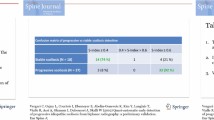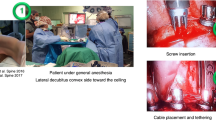Abstract
Adolescent idiopathic scoliosis (AIS) progression is clinically monitored by a series of full spinal X-rays. To decrease radiation exposure, an artificial progression surface (APS) is proposed to predict progression. Fifty-six acquisitions (posteroanterior radiographs, 0° and 20°) were obtained from 11 AIS patients (29.8 ± 9.6° Cobb angle). Three-dimensional curves were constructed through vertebral pedicle centers. Three previous serial spinal curves (6-month intervals) were used to construct an APS with a Non-uniform Rational B-Spline surfacing technique. Future progression was achieved by aligning the curves on the APS using the generalized cross-validation extrapolation technique. With three and four previous serial spinal curves, the prediction accuracies of future progression at the next 6-month interval were 4.1 ± 3.3° for Cobb angles and 3.6 ± 3.5 mm for apex lateral deviations. Apex locations and Cobb regions varied within one vertebral level. The proposed technique shows potential as an accurate three-dimensional prediction method for AIS progression and could help pediatricians make decisions about treatment. However, it could only be applied once before more radiographic data would be needed.



Similar content being viewed by others
References
Aubin CE, Dansereau J, Parent F et al (1997) Morphometric evaluations of personalised 3d reconstructions and geometric models of the human spine. Med Biol Eng Comput 35:611–618
Bengio S, Fessant F, and Collobert D (1995) A connectionist system for medium-term horizon time series prediction. In: Proceedings of the international workshop on applied neural networks to telecommunications
Burwell RG, Cole AA, Cook TA et al (1992) Pathogenesis of idiopathic scoliosis. The Nottingham concept. Acta Orthop Belg 58(Suppl 1):33–58
Carman DL, Browne RH, Birch JG (1990) Measurement of scoliosis and kyphosis radiographs. Intraobserver and interobserver variation. J Bone Joint Surg Am 72:328–333
Closkey RF, Schultz AB (1993) Rib cage deformities in scoliosis: spine morphology, rib cage stiffness, and tomography imaging. J Orthop Res 11:730–737
Delorme S, Petit Y, de Guise JA et al (2003) Assessment of the 3-d reconstruction and high-resolution geometrical modeling of the human skeletal trunk from 2-d radiographic images. IEEE Trans Biomed Eng 50:989–998
Don S (2004) Radiosensitivity of children: potential for overexposure in CR and DR and magnitude of doses in ordinary radiographic examinations. Pediatr Radiol 34(Suppl 3):S167–S172
Duval-Beaupere G (1971) Pathogenic relationship between scoliosis and growth. Churchill Livingstone, Edinburgh
Duval-Beaupere G (1992) Rib hump and supine angle as prognostic factors for mild scoliosis. Spine 17:103–107
Edwards T, Tansley SW, Davey N et al (1997) Traffic trends analysis using neural networks. Proc Int Workshop Appl Neural Netw Telecom 3:157–164
Goldberg CJ, Dowling FE, Hall JE et al (1993) A statistical comparison between natural history of idiopathic scoliosis and brace treatment in skeletally immature adolescent girls. Spine 18:902–908
Kadoury S, Cheriet F, Laporte C, Labelle H (2007) A versatile 3D reconstruction system of the spine and pelvis for clinical assessment of spinal deformities. Med Bio Eng Comput 45:591–602
Karol LA, Johnston CE 2nd, Browne RH et al (1993) Progression of the curve in boys who have idiopathic scoliosis. J Bone Joint Surg Am 75:1804–1810
Korovessis P, Piperos G, Sidiropoulos P et al (1994) Adult idiopathic lumbar scoliosis. A formula for prediction of progression and review of the literature. Spine 19:1926–1932
Labelle H, Dansereau J, Bellefleur C et al (1995) Variability of geometric measurements from three-dimensional reconstructions of scoliotic spines and rib cages. Eur Spine J 4:88–94
Lee K (1999) Principles of cad/cam/cae systems. Prentice Hall, New York
Lenke LG, Betz RR, Harms J et al (2001) Adolescent idiopathic scoliosis: a new classification to determine extent of spinal arthrodesis. J Bone Joint Surg Am 83-A:1169–1181
Levy AR, Goldberg MS, Mayo NE et al (1996) Reducing the lifetime risk of cancer from spinal radiographs among people with adolescent idiopathic scoliosis. Spine 21:1540–1547
Marzan GT (1976) Rational design for close range photogrammetry. Ph.D., University of Illinois at Urbana-Champaign, Urbana, IL
Masters T (1993) Practical neural network recipes in c++. Academic Press, California
Mehta MH (1972) The rib-vertebra angle in the early diagnosis between resolving and progressive infantile scoliosis. J Bone Joint Surg Br 54:230–243
Murray DW, Bulstrode CJ (1996) The development of adolescent idiopathic scoliosis. Eur Spine J 5:251–257
Oestreich AE, Young LW, Young Poussaint T (1998) Scoliosis circa 2000: radiologic imaging perspective I. Diagnosis and pretreatment evaluation. Skeletal Radiol 27:591–605
Patterson DW, Chan KH, and Tan CM (1993) Time series forecasting with neural nets: A comparative study. In: Proceedings of the international conference on neural network applications to signal processing, Singapore
Perdriolle R, Becchetti S, Vidal J et al (1993) Mechanical process and growth cartilages. Essential factors in the progression of scoliosis. Spine 18:343–349
Peterson LE, Nachemson AL (1995) Prediction of progression of the curve in girls who have adolescent idiopathic scoliosis of moderate severity. Logistic regression analysis based on data from the brace study of the scoliosis research society. J Bone Joint Surg Am 77:823–827
Poncet P, Delorme S, Ronsky JL, Dansereau J, Clynch G, Harder J, Dewar RD, Labelle H, Gu PH, Zernicke RF (2000) Reconstruction of laser-scanned 3D torso topography and stereoradiographical spine and rib-cage geometry in scoliosis. Comput Methods Biomech Biomed Eng 4:59–75
Poncet P, Dansereau J, Labelle H (2001) Geometric torsion in idiopathic scoliosis: three-dimensional analysis and proposal for a new classification. Spine 26:2235–2243
Pope MH, Stokes IA, Moreland M (1984) The biomechanics of scoliosis. Crit Rev Biomed Eng 11:157–188
Reamy BV, Slakey JB (2001) Adolescent idiopathic scoliosis: review and current concepts. Am Fam Physician 64:111–116
Samuelsson L, Norén L (1997) Trunk rotation in scoliosis. The influence of curve type and direction in 150 children. Acta Orthop Scand 68(3):273–276
Soucacos PN, Zacharis K, Gelalis J et al (1998) Assessment of curve progression in idiopathic scoliosis. Eur Spine J 7:270–277
Stokes IA, Shuma-Hartswick D, Moreland MS (1988) Spine and back-shape changes in scoliosis. Acta Orthop Scand 59:128–133
Stokes IA, Dansereau J, Moreland MS (1989) Rib cage asymmetry in idiopathic scoliosis. J Orthop Res 7:599–606
Wright N (2000) Imaging in scoliosis. Arch Dis Child 82:38–40
Yamauchi Y, Yamaguchi T, Asaka Y (1988) Prediction of curve progression in idiopathic scoliosis based on initial roentgenograms. A proposal of an equation. Spine 13:1258–1261
Ylikoski M (1993) Spinal growth and progression of adolescent idiopathic scoliosis. Eur Spine J 1:236–239
Acknowledgments
The authors would like to gratefully acknowledge the financial support from Canadian Institutes of Health Research (CIHR), Alberta Children’s Hospital Foundation, Fraternal Order of Eagles (Alberta & Saskatchewan), Lew Reed Spinal Cord Injury Foundation, Alberta Ingenuity Fund (AIF), and the Natural Sciences and Engineering Research Council of Canada (NSERC).
Author information
Authors and Affiliations
Corresponding author
Rights and permissions
About this article
Cite this article
Wu, H., Ronsky, J.L., Cheriet, F. et al. Prediction of scoliosis progression with serial three-dimensional spinal curves and the artificial progression surface technique. Med Biol Eng Comput 48, 1065–1075 (2010). https://doi.org/10.1007/s11517-010-0654-6
Received:
Accepted:
Published:
Issue Date:
DOI: https://doi.org/10.1007/s11517-010-0654-6




